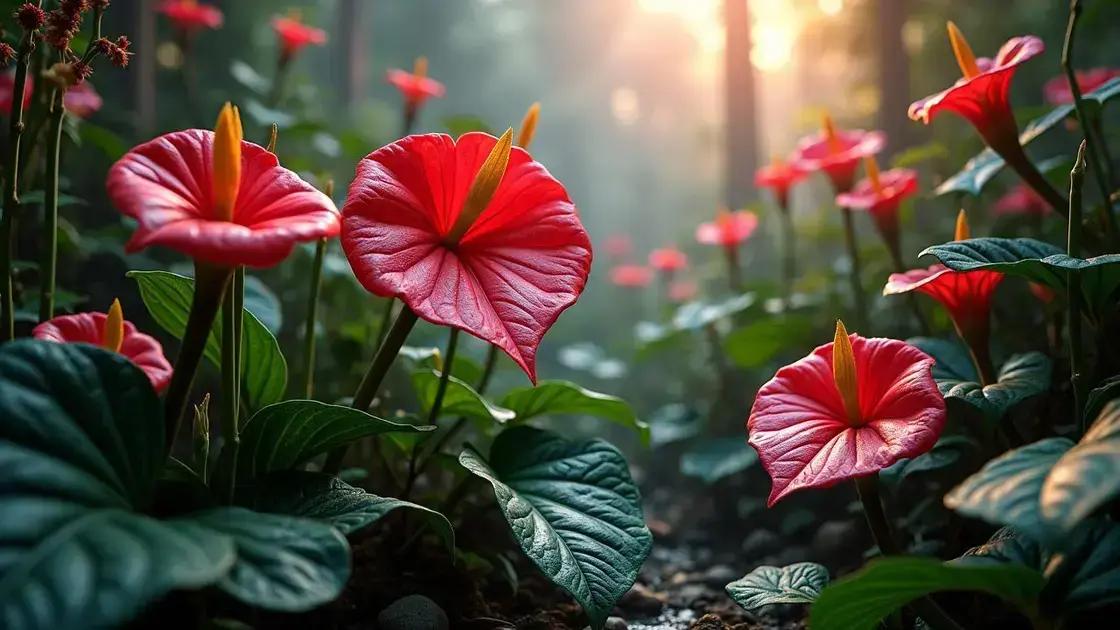How to Care for a Anthurium Plant: 5 Essential Tips for Success
How to care for a anthurium plant can often feel overwhelming, especially for those new to indoor gardening. With vibrant blooms and unique foliage, these plants bring life to any space. But what makes them thrive? Dive into this guide and uncover essential tips and best practices to keep your anthurium flourishing!
Table of Contents
ToggleThe best watering techniques for anthurium plants
How to care for a anthurium plant involves understanding the best watering techniques that keep this vibrant plant healthy and thriving. Proper hydration is crucial, as overwatering or underwatering can both lead to problems. Let’s explore how to give your anthurium the right amount of water!
- Watering frequency: Water your anthurium when the top inch of soil feels dry to the touch. This usually translates to watering once a week, but it’s essential to adjust based on environmental conditions.
- Watering method: Water until it flows out of the drainage holes. This ensures that the entire root system gets hydrated adequately but prevents standing water, which can lead to root rot.
- Water quality: Use room temperature, distilled or rainwater. This will help avoid chlorine and other chemicals found in tap water, promoting healthier plant growth.
Understanding anthurium’s water needs
Different factors can affect how much water your anthurium needs:
- Humidity: Anthuriums thrive in high humidity. If your environment is dry, you might need to water more often.
- Temperature: Warmer temperatures increase evaporation rates, leading to more frequent watering.
- Soil type: Well-draining soil mixtures, such as peat-based or orchid mixes, retain moisture without becoming soggy.
Common watering mistakes to avoid
When caring for an anthurium, it’s easy to make mistakes. Here are the most common:
- Overwatering, which can lead to root rot, is one of the biggest issues. Always ensure that the pot has good drainage to avoid standing water.
- Underwatering can cause wilting and leaf drop. Always monitor the soil moisture, especially during hotter months.
- Ignoring environmental changes. Seasonal changes can alter how often you need to water your plant.
Keeping a consistent watering schedule while adjusting based on the plant’s conditions will help you enjoy the beautiful flowers of an anthurium. For more advanced tips, consider exploring indoor gardening techniques that can improve your plant care experience.
Understanding light requirements for your anthurium

Understanding light requirements for your anthurium is crucial for healthy growth and vibrant blooms. This beautiful plant thrives best when given the right conditions, and light plays a significant role in that.
Types of light for anthurium plants
Anthuriums do best with bright, indirect light. Here are the main types of light to consider:
- Bright, indirect sunlight: This is optimal for your anthurium. Place it near a window with filtered light, ensuring that direct sun does not scorch the leaves.
- Medium light: If only medium light is available, your plant will survive, but growth may slow, and blooms might be less vibrant.
- Low light: Anthuriums can tolerate low light, but they won’t thrive. Low light may lead to leggy growth and fewer flowers.
Signs your anthurium needs more light
Monitoring your anthurium for signs of inadequate light is essential:
- Leaves turning yellow or dropping off.
- Stunted growth or elongated stems that appear leggy.
- Reduced flowering or lack of blooms altogether.
Adjusting light conditions
If your anthurium isn’t thriving, consider these adjustments:
- Move the plant closer to a window or add sheer curtains to filter light.
- Rotate the plant periodically to ensure even light exposure on all sides.
- Use grow lights if natural light is limited, ensuring they provide light in the right spectrum.
Proper light conditions are vital for a flourishing anthurium plant. For more comprehensive care insights, you might enjoy exploring indoor gardening techniques that can enhance your gardening skills.
Common anthurium problems and how to fix them
Common anthurium problems and how to fix them are essential for keeping your plant vibrant and healthy. Gardeners often encounter a few recurrent issues with anthuriums, but understanding these problems can help you take corrective actions quickly.
Identifying common anthurium issues
Several problems can affect your anthurium, and recognizing them early is key to ensuring its health:
- Yellowing leaves: This can result from overwatering or nutrient deficiencies.
- Brown spots on leaves: This is often a sign of underwatering or sunburn.
- Dropping flowers and leaves: This may indicate stress from temperature changes or improper lighting.
- Leggy growth: Not getting enough light can cause stretches between leaves.
How to address these problems
Once you identify the issue, here are practical fixes:
- For yellowing leaves: Check your watering schedule and adjust to prevent waterlogged soil. Also, ensure you’re providing the right nutrients.
- For brown spots: Move your anthurium to a shadier spot and make sure you are watering consistently.
- For dropping leaves: Stabilize the plant’s environment by keeping it away from drafts and ensuring it receives consistent light.
- For leggy growth: Increase light exposure; consider moving it closer to a bright window or using grow lights.
Regularly monitoring your anthurium will help you spot issues early. Exploring different indoor gardening techniques can also enhance your plant care knowledge, providing deeper insights into keeping your anthurium thriving.
In conclusion
Caring for anthuriums is a rewarding journey that requires understanding their unique needs, from watering techniques to light requirements and addressing common problems. By applying the tips shared throughout this guide, you can ensure your anthurium thrives and showcases its vibrant beauty in your home. For additional guidance on enhancing your indoor garden, be sure to check out tips on enhancing your indoor garden.

